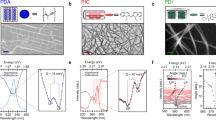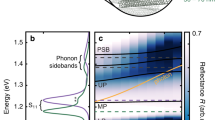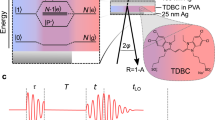Abstract
Strongly coupled optical microcavities containing different exciton states permit the creation of hybrid-polariton modes that can be described in terms of a linear admixture of cavity-photon and the constituent excitons. Such hybrid states have been predicted to have optical properties that are different from their constituent parts, making them a test bed for the exploration of light–matter coupling. Here, we use strong coupling in an optical microcavity to mix the electronic transitions of two J-aggregated molecular dyes and use both non-resonant photoluminescence emission and photoluminescence excitation spectroscopy to show that hybrid-polariton states act as an efficient and ultrafast energy-transfer pathway between the two exciton states. We argue that this type of structure may act as a model system to study energy-transfer processes in biological light-harvesting complexes.
This is a preview of subscription content, access via your institution
Access options
Subscribe to this journal
Receive 12 print issues and online access
$259.00 per year
only $21.58 per issue
Buy this article
- Purchase on Springer Link
- Instant access to full article PDF
Prices may be subject to local taxes which are calculated during checkout





Similar content being viewed by others
References
Weisbuch, C., Nishioka, M., Ishikawa, A. & Arakawa, Y. Observation of the coupled exciton–photon mode splitting in a semiconductor quantum microcavity. Phys. Rev. Lett. 69, 3314–3317 (1992).
Houdré, R. et al. Measurement of cavity-polariton dispersion curve from angle-resolved photoluminescence experiments. Phys. Rev. Lett. 73, 2043–2046 (1994).
Tassone, F., Piermarocchi, C., Savona, V., Quattropani, A. & Schwendimann, P. Bottleneck effects in the relaxation and photoluminescence of microcavity polaritons. Phys. Rev. B 56, 7554–7563 (1997).
Butté, R. et al. Room-temperature polariton luminescence from a bulk GaN microcavity. Phys. Rev. B 73, 033315 (2006).
Christopoulos, S. et al. Room-temperature polariton lasing in semiconductor microcavities. Phys. Rev. Lett. 98, 126405 (2007).
Lidzey, D. G. et al. Strong exciton–photon coupling in an organic semiconductor microcavity. Nature 395, 53–55 (1998).
Savvidis, P. G., Connolly, L. G., Skolnick, M. S., Lidzey, D. G. & Baumberg, J. J. Ultrafast polariton dynamics in strongly coupled zinc porphyrin microcavities at room temperature. Phys. Rev. B 74, 113312 (2006).
Lidzey, D. G. et al. Room temperature polariton emission from strongly coupled organic semiconductor microcavities. Phys. Rev. Lett. 82, 3316–3319 (1999).
Schouwink, P., Berlepsch, H. V., Dähne, L. & Mahrt, R. F. Observation of strong exciton–photon coupling in an organic microcavity. Chem. Phys. Lett. 344, 352–356 (2001).
Tischler, J. R., Bradley, M. S., Bulović, V., Song, J. H. & Nurmikko, A. Strong coupling in a microcavity LED. Phys. Rev. Lett. 95, 036401 (2005).
Holmes, R. J. & Forrest, S. R. Strong exciton–photon coupling and exciton hybridization in a thermally evaporated polycrystalline film of an organic small molecule. Phys. Rev. Lett. 93, 186404 (2004).
Kéna-Cohen, S., Davanço, M. & Forrest, S. R. Strong exciton–photon coupling in an organic single crystal microcavity. Phys. Rev. Lett. 101, 116401 (2008).
Kéna-Cohen, S. & Forrest, S. Room-temperature polariton lasing in an organic single-crystal microcavity. Nature Photon. 4, 371–375 (2010).
Takada, N., Kamata, T. & Bradley, D. D. C. Polariton emission from polysilane-based organic microcavities. Appl. Phys. Lett. 82, 1812–1814 (2003).
Agranovich, V., Benisty, H. & Weisbuch, C. Organic and inorganic quantum wells in a microcavity: Frenkel–Wannier–Mott excitons hybridization and energy transformation. Solid State Commun. 102, 631–636 (1997).
Holmes, R. J., Kéna-Cohen, S., Menon, V. M. & Forrest, S. R. Strong coupling and hybridization of Frenkel and Wannier–Mott excitons in an organic–inorganic optical microcavity. Phys. Rev. B 74, 235211 (2006).
Wenus, J. et al. Hybrid organic–inorganic exciton–polaritons in a strongly coupled microcavity. Phys. Rev. B 74, 235212 (2006).
Lidzey, D. G., Bradley, D. D. C., Armitage, A., Walker, S. & Skolnick, M. S. Photon-mediated hybridization of Frenkel excitons in organic semiconductor microcavities. Science 288, 1620–1623 (2000).
Lidzey, D. G. et al. Hybrid polaritons in strongly coupled microcavities: experiments and models. J. Lumin. 110, 347–353 (2004).
Wainstain, J. et al. Dynamics of polaritons in a semiconductor multiple-quantum-well microcavity. Phys. Rev. B 58, 7269–7278 (1998).
Lodden, G. H. & Holmes, R. J. Long-range, photon-mediated exciton hybridization in an all-organic, one-dimensional photonic crystal. Phys. Rev. Lett. 109, 096401 (2012).
Engel, G. S. et al. Evidence for wavelike energy transfer through quantum coherence in photosynthetic systems. Nature 446, 782–786 (2007).
Collini, E. et al. Coherently wired light-harvesting in photosynthetic marine algae at ambient temperature. Nature 463, 644–647 (2010).
Tischler, J. R. et al. Solid state cavity QED: Strong coupling in organic thin films. Org. Electron. 8, 94–113 (2007).
Brumbaugh, D. V., Muenter, A. A., Knox, W., Mourou, G. & Wittmershaus, B. Singlet exciton annihilation in the picosecond fluorescence decay of 1,1’-diethyl-2,2’-cyanine chloride dye j-aggregate. J. Lumin. 3132, Part 2, 783–785 (1984).
Sundström, V., Gillbro, T., Gadonas, R. A. & Piskarskas, A. Annihilation of singlet excitons in j aggregates of pseudoisocyanine (pic) studied by pico- and subpicosecond spectroscopy. J. Chem. Phys. 89, 2754–2762 (1988).
Stiel, H., Daehne, S. & Teuchner, K. J-aggregates of pseudoisocyanine in solution: New data from nonlinear spectroscopy. J. Lumin. 39, 351–357 (1988).
Moll, J., Harrison, W. J., Brumbaugh, D. V. & Muenter, A. A. Exciton annihilation in j-aggregates probed by femtosecond fluorescence upconversion. J. Phys. Chem. A 104, 8847–8854 (2000).
Akselrod, G. M., Tischler, Y. R., Young, E. R., Nocera, D. G. & Bulović, V. Exciton–exciton annihilation in organic polariton microcavities. Phys. Rev. B 82, 113106 (2010).
Andreani, L., Savona, V., Schwendimann, P. & Quattropani, A. Polaritons in high reflectivity microcavities: semiclassical and full quantum treatment of optical properties. Superlatt. Microstruct. 15, 453–458 (1994).
Skolnick, M. S., Fisher, T. A. & Whittaker, D. M. Strong coupling phenomena in quantum microcavity structures. Semicond. Sci. Technol. 13, 645–669 (1998).
Agranovich, V. M., Litinskaia, M. & Lidzey, D. G. Cavity polaritons in microcavities containing disordered organic semiconductors. Phys. Rev. B 67, 085311 (2003).
Coles, D. M., Grant, R. T., Lidzey, D. G., Clark, C. & Lagoudakis, P. G. Imaging the polariton relaxation bottleneck in strongly coupled organic semiconductor microcavities. Phys. Rev. B 88, 121303 (2013).
Michetti, P. & La Rocca, G. C. Simulation of j-aggregate microcavity photoluminescence. Phys. Rev. B 77, 195301 (2008).
Michetti, P. & La Rocca, G. C. Exciton–phonon scattering and photoexcitation dynamics in j-aggregate microcavities. Phys. Rev. B 79, 035325 (2009).
Michetti, P. & La Rocca, G. C. Simulation of the time dependent photoluminescence of a j-aggregate microcavity. Phys. Status Solidi C 6, 403–406 (2009).
Agranovich, V. M., Litinskaya, M. & Lidzey, D. G. Microcavity polaritons in materials with weak intermolecular interaction. Phys. Status Solidi B 234, 130–138 (2002).
Litinskaya, M., Reineker, P. & Agranovich, V. M. Fast polariton relaxation in strongly coupled organic microcavities. J. Lumin. 110, 364–372 (2004).
Litinskaya, M., Reineker, P. & Agranovich, V. M. Exciton–polaritons in organic microcavities. J. Lumin. 119–120, 277–282 (2006).
Chovan, J., Perakis, I. E., Ceccarelli, S. & Lidzey, D. G. Controlling the interactions between polaritons and molecular vibrations in strongly coupled organic semiconductor microcavities. Phys. Rev. B 78, 045320 (2008).
Michetti, P. & La Rocca, G. C. Polariton states in disordered organic microcavities. Phys. Rev. B 71, 115320 (2005).
Michetti, P. & Rocca, G. L. Polariton dynamics in disordered microcavities. Physica E 40, 1926–1929 (2008).
Lidzey, D. G. et al. Experimental study of light emission from strongly coupled organic semiconductor microcavities following nonresonant laser excitation. Phys. Rev. B 65, 195312 (2002).
Coles, D. M., Michetti, P., Clark, C., Adawi, A. M. & Lidzey, D. G. Temperature dependence of the upper-branch polariton population in an organic semiconductor microcavity. Phys. Rev. B 84, 205214 (2011).
Coles, D. M. et al. Vibrationally assisted polariton-relaxation processes in strongly coupled organic-semiconductor microcavities. Adv. Funct. Mater. 21, 3691–3696 (2011).
Müller, M., Bleuse, J., André, A. & Ulmer-Tuffigo, H. Observation of bottleneck effects on the photoluminescence from polaritons in ii–iv microcavities. Physica B 272, 476–479 (1999).
Tartakovskii, A. I. et al. Relaxation bottleneck and its suppression in semiconductor microcavities. Phys. Rev. B 62, R2283–R2286 (2000).
Virgili, T. et al. Ultrafast polariton relaxation dynamics in an organic semiconductor microcavity. Phys. Rev. B 83, 245309 (2011).
Acknowledgements
We gratefully acknowledge R.T. Grant for the atomic force micrographs presented in the Supplementary Information. We acknowledge financial support for the work via the UK EPSRC through grant EP/G062404/1 and by the European Union through the FP7 funded project Icarus (237900).
Author information
Authors and Affiliations
Contributions
D.G.L. and D.M.C. conceived the experiment. Samples were prepared by C.C. and D.M.C. Steady-state measurements were performed by D.M.C. N.S. performed time-resolved measurements under the supervision of P.G.L. and P.G.S. The model was developed by P.M. All authors contributed to the interpretation of results and preparation of the manuscript.
Corresponding author
Ethics declarations
Competing interests
The authors declare no competing financial interests.
Supplementary information
Supplementary Information
Supplementary Information (PDF 2296 kb)
Rights and permissions
About this article
Cite this article
Coles, D., Somaschi, N., Michetti, P. et al. Polariton-mediated energy transfer between organic dyes in a strongly coupled optical microcavity. Nature Mater 13, 712–719 (2014). https://doi.org/10.1038/nmat3950
Received:
Accepted:
Published:
Issue Date:
DOI: https://doi.org/10.1038/nmat3950
This article is cited by
-
Strong coupling in plasmonic metal nanoparticles
Nano Convergence (2023)
-
Ultrafast imaging of polariton propagation and interactions
Nature Communications (2023)
-
Minimizing non-radiative decay in molecular aggregates through control of excitonic coupling
Nature Communications (2023)
-
Effect of nanoshell geometries, sizes, and quantum emitter parameters on the sensitivity of plasmon-exciton hybrid nanoshells for sensing application
Scientific Reports (2023)
-
Multi-scale molecular dynamics simulations of enhanced energy transfer in organic molecules under strong coupling
Nature Communications (2023)



